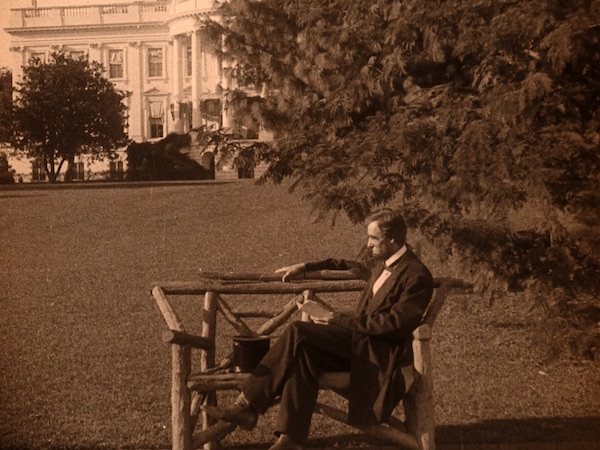THE LINCOLN CYCLE
Benjamin Chapin, [John M. Stahl] (US 1917)
The Lincoln Cycle is today considered John Stahl’s earliest surviving work, but at the time of its release it was completely identified with Benjamin Chapin, a noted theatrical impersonator of Abraham Lincoln. Chapin not only took credit for writing, producing, and directing the series, but even suppressed the names of the other actors who appeared in it with him. He had begun thinking about extending his brand into the motion picture field as early as 1913, and the following year incorporated Charter Films to produce The Lincoln Cycle, not as a solitary feature, but a sequential narrative whose structural complexity, he said, was modeled on Wagner’s Ring Cycle. The series of stand-alone subjects would not be linked chronologically, like a serial, but thematically, with all episodes designed to address one central question: if Abraham Lincoln was America’s greatest president, what experiences acted to shape the development of his social, ethical, and political character?
At a time when short films, serial films, and feature-length narratives all offered competing visions of the cinema’s future, The Lincoln Cycle – an independent project with no link to existing distribution or exhibition structures – appeared as just another eccentric vision with no prospect of finding an audience. All that changed in the summer of 1915, when the success of The Birth of a Nation revived American filmmakers’ interest in the Civil War, while the continuing struggle in Europe highlighted, even for neutrals, issues of liberty, honor, nationhood, and sacrifice. Charter’s response was to advertise for additional technical staff, including “a Director of the most pronounced ability” to supplement Chapin’s existing unit. This seems to have been the moment Stahl came aboard, although Charter’s publicity arm, designed to focus all attention on Chapin, never admitted the fact.
When a selection of the films was screened at the Strand Theatre in New York in May 1917, critics wondered why the only person credited was Benjamin Chapin. Stahl, who had previously been denied credit on his first film, A Boy and the Law, was not about to see this happen again. He not only leaked the names of actors Madelyn Clare and Charlie Jackson, but informed the press that it was he who had “directed Mr. Chapin’s Lincoln Cycle, but was given no credit whatsoever by Chapin.” Charter Films, and all subsequent distributors of the Cycle, never granted credit to anyone but Chapin, but neither did they contest Stahl’s claims, which he continued to assert throughout his career.
Chapin was never able to complete production of The Lincoln Cycle and before his death sold ten episodes to Paramount, which distributed them as The Son of Democracy. In the 1920s they were repackaged for the educational market and widely circulated on 35mm diacetate safety stock.
It is impossible to say just how much control Stahl exercised over the series. Many events depicted do not recall any of Chapin’s theatrical productions, especially the emphasis on young Abe’s relationship with his mother in the first episode, or the continuing concern with slavery and racial injustice, seen in My First Jury, Down the River, and The Slave Auction (these last two episodes are unfortunately missing). Fifty years after his death, Lincoln was usually characterized as a conciliator who worked to heal the nation’s wounds. But The Lincoln Cycle focuses instead on his sense of patriotism and justice, and refers to the rebels as traitors, an unusually blunt position noted with surprise by reviewers.
Even more striking is the way in which the Cycle uses memory. The films incorporate flashbacks as a basic structuring device illustrating how formative experiences shape our entire character, not simply our response to some specific problem. Repetitive flashbacks, generally used to show the conflicting recollections of different characters (Rashomon), are employed here to show how the same character could draw more than one lesson from a single experience. The films sometimes illustrate this by recalling an event through the use of slightly different footage, as in Lincoln’s history with the Carter family or events in the life of his grandfather, which come back in various guises throughout the Cycle.
Although each episode was advertised as a self-contained dramatic unit, this ambitious narrative structure suggests that Chapin – like Wagner – expected the public to enjoy the total effect only by experiencing the entire Cycle at full length. Needless to say, few audiences would ever have had the opportunity to do so. For more on this, see my article, “Benjamin Chapin: The Lincoln Man and His Lincoln Cycle,” Film History 30.2 (Summer 2018).
Richard Koszarski

orig. 10 ep.: My Mother, My Father, The Call to Arms, My First Jury, Tender Memories, A President’s Answer, Native State, Down the River, The Slave Auction, Under the Stars.
2 ep. mancanti/missing: Down the River; The Slave Auction.
regia/dir: Benjamin Chapin, [John M. Stahl].
scen: Benjamin Chapin, [Paul Bern, Monte Katterjohn, William B. Laub, Donald Buchanan].
photog: [J. Roy Hunt, Harry Fischbeck, Walter Blakeley, ? Freyer].
cast: Benjamin Chapin (Abraham Lincoln; Tom Lincoln, his father; Abraham Lincoln, his grandfather), [Charlie Jackson (Lincoln as a boy), Madelyn Clare (Nancy Hanks Lincoln, his mother), Alice Inwood, Florence Short, Joseph Monahan (Willie Lincoln)?, John Stafford (Carter)?].
prod: Benjamin Chapin, Charter Features Corp.
uscita/rel: 04-10.03.1917 (1 ep., Belasco Th., Washington, DC); 27.05.1917 (4 ep., Strand Th., New York); 11.02.1918 (“The Son of Democracy”, 10 x 2-rl. ep., dist. Paramount); reissue 1921. copia/copy: 8 ep., DCP (da/from 35mm): My Mother (25’49”), My Father (25’59”), The Call to Arms (26’08”), My First Jury (28’35”), Tender Memories (28’53”), A President’s Answer (24’36”), Native State (29’56”), Under the Stars (27’18”); did./titles: ENG.
fonte/source: Library of Congress Packard Center for Audio-Visual Conservation, Culpeper, VA.


 Italiano
Italiano